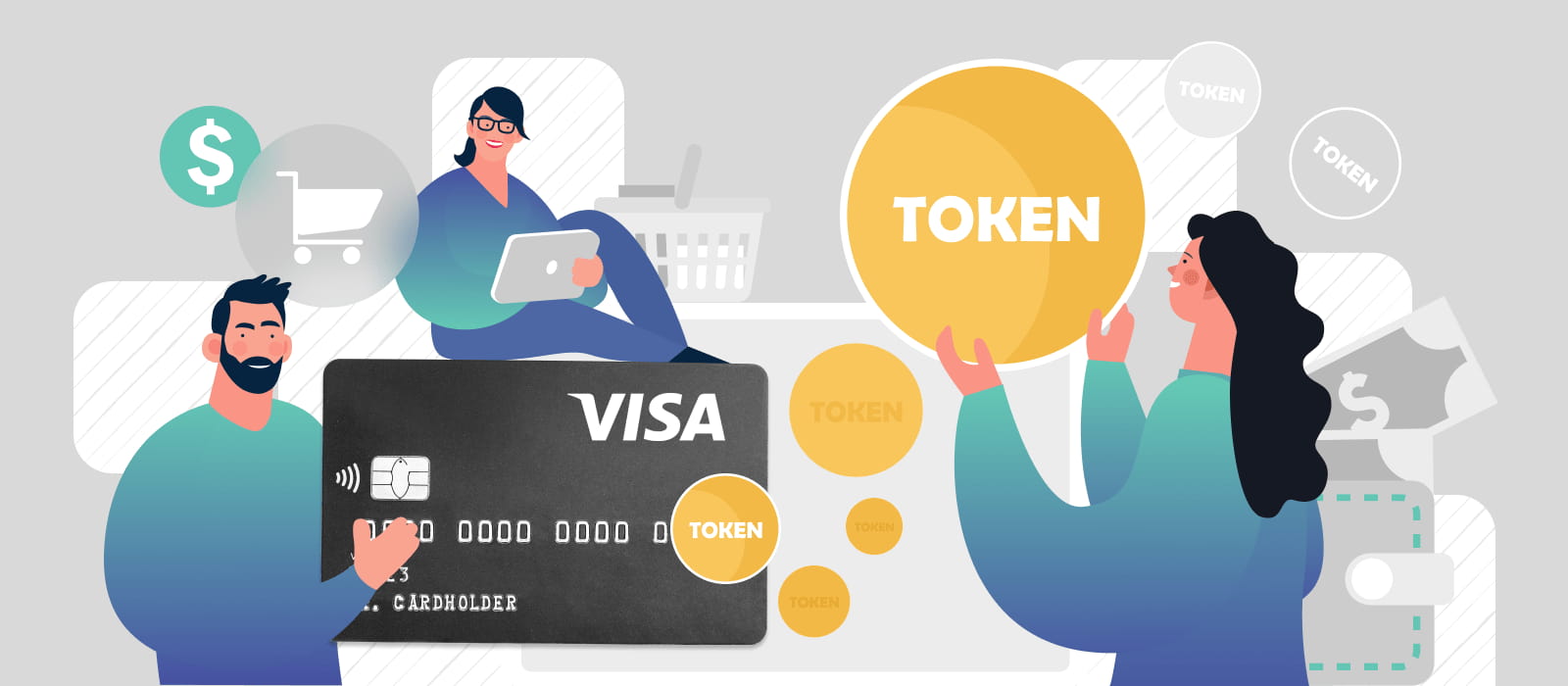The safety and security of digital transactions still need some improvement. Considering this, Visa has embraced tokenization and introduced its Visa Token Service, which guarantees the security of digital payments and simplifies the purchasing experience.
Over the past few years, digital payments have been seeing a massive rise in popularity. However, the impact of the Covid-19 pandemic has contributed enormously to an even more considerable digital shift within societies across the globe. The crisis has radically changed the way we live, work, communicate, and, not least, shop — therefore, we’ve started using digital payments much more often to obtain the goods and services that we need the most.
However, there has been a corresponding increase in the amount of fraudulent activity, with hackers attempting to steal card holders’ personal information. According to a new study conducted by Juniper Research: “Online payment fraud: emerging threats, segment analysis & market forecasts 2020-2024”, businesses in eCommerce, airline ticketing, money transfer, and banking services may lose about $200 billion due to online payment fraud between 2020 and 2024 if no measures are taken.
Considering these challenges, Visa Inc., an American multinational financial services corporation, has joined a rapidly progressing, security-oriented tokenization trend and introduced its Visa Token Service (VTS) aimed at reducing digital fraud and contributing to more efficient and secure digital commerce.
Read on to discover how the Visa Token Service works and how it can improve the eCommerce sector, what other Visa tokenization solutions exist, and what Visa’s value-added services can offer.
First and foremost: what is tokenization?
Tokenization is a process of replacing sensitive information with a unique identifier, also known as a “token”, which is created to protect the underlying confidential data. In the payment sector, tokenization is used to secure a card’s PAN by substituting it with a unique string of numbers that cannot be stolen or re-used.
Apart from greater security, tokenization also contributes to friction reduction during the payment process, as customers are not required to manually update stored card information if their card has been lost or expired. Instead, financial institutions, e.g. banks, will be able to automatically update expired or compromised payment credentials. Consequently, this will lead to fewer missed payments for merchants and allow customers to avoid undesirable late payment fees and/or charges.
The benefits of tokenization outlined above mean that it is sure to become even more of a driving force in digital payments, especially considering the fact that digital shopping is ever more ingrained in our lives and we will need the best possible security for our digital payments.
Get to know which countries and businesses accept Bitcoin payments
Visa’s tokenization
![]()
By embracing tokenization, Visa has managed to tokenize its branded payment cards and become the key player in the US card market. Back in 2014, Visa launched its Visa Token Service and since then the company has welcomed more than 150 global token requestors, including mobile and wearables manufacturers, issuer wallets, online merchants, and retailers who are eagerly adopting the new ingenious technology.
The Visa Token Service (VTS) is a novel security technology by Visa Inc. that replaces sensitive account information — the 16-digit primary account number, or PAN — with a unique digital identifier called a token, which enables payment processing without exposing the account details. The VTS has been essential to minimizing digital fraud all over the world and making eCommerce more secure for different types of digital transactions. Thanks to Visa tokens, it’s been possible to reduce fraud by 26% compared to traditional online card transactions where users have to enter their PAN online.
In February 2020, Visa Inc. announced that its VTS participants were estimated to have processed a combined eCommerce volume of about $1 trillion, thus marking a considerable milestone in its efforts to make digital payments more secure and trouble-free.
To provide even greater security, the Visa Token Service always welcomes new participants who can act as credential-on-file (COF) token requesters and help make digital payments more secure. So, for instance, in May 2020 Visa announced that 28 new partners would join the initiative, including Aurus, PayVision, Yandex.Money, and many others.
How the Visa Token Service works
According to the statistics provided by Visa, as of April 2021, the Visa Token Service issued 2+billion tokens, and around 615, 000 merchants around the world were transacting via Visa tokens.
Thanks to the VTS, digital payment service providers as well as financial institutions have been able to provide their customers with a reliable and safe way to shop both online and with their mobile devices. But what does the entire procedure of token initiation look like? Let’s find out together.
- 1. The consumer registers their Visa account and enrolls with a digital payment service (e.g. an online retailer or mobile wallet) by providing their primary account number (PAN), and security code 1 as well as other payment account data.
- 2. The digital payment service provider makes a request to Visa to share a payment token for the registered account.
- 3. Upon receiving the request, Visa shares it with the account issuer (e.g. the consumer’s bank).
- 4. Once the issuer’s account has been approved, Visa replaces the consumer’s PAN with a token — a unique digital identifier.
- 5. Finally, Visa provides the token to its requestor. The token can be used for both mobile (NFC) and online payment use. This payment token can be restricted to a particular mobile device, eCommerce merchant, or a limited number of purchases before expiring.
Although the issuing of Visa tokens may initially sound a bit complicated, it takes only five steps to complete the process and enjoy all its advantages.
Check out this elaborate, multi-platform end-to-end eCommerce solution for a grocery store chain
How to use Visa tokens
Given that consumers prefer to shop with different connected devices, it’s of prime importance to introduce a secure digital payment environment everywhere. As of today, it’s possible to use the Visa Token Service online, in-store, and in a mobile application (in-app). No matter which option you will choose, the principle of using Visa tokens is the same. Below, we outline what the entire procedure looks like.
- 1. The payment procedure is initiated. The consumer initiates a payment (online/ in-store, or in-app).
- 2. The merchant sends a token to the acquirer. In accordance with the commerce environment, the digital payment service provider (e-wallet, eCommerce merchant, or app) sends the token to the acquirer in the form of an authorization request.
- 3. The acquirer forwards the token. Upon receiving the token, the acquirer forwards it to Visa’s network to start processing the transaction.
- 4. Visa sends the token to the card issuer. Visa, in its turn, sends the token as well as the payment card details to the issuer for authorization.
- 5. The issuer returns the token. The issuer either accepts or declines the transaction and sends the response to Visa.
- 6. The transaction is completed. The token and payment authorization are forwarded back to the acquirer (the merchant’s bank).
Any other tokenization solutions? — Yes
![]()
Apart from its Visa Token Service, Visa has some other elaborate tokenization technologies. Each Visa tokenization solution is unique and provides complete flexibility to users who want better and more personalized experiences. Among them are Token Management Service (TMS) by Cybersource and Token ID — a Visa Solution.
Token Management Service (TMS) by Cybersource
Back in 2010, Visa Inc. acquired Cybersource, a company that majors in providing a payment gateway for online merchants and connecting them with different networks (e.g. Visa and Mastercard). Once Cybersource became a Visa platform, it gained access to numerous issuers and acquirers as well as Visa’s top security infrastructure.
Together with Cybersource, Visa developed the Token Management Service (TMS), which delivers a single seamless token while combining several individual tokens. This contributes to better, more efficient, and more secure eCommerce. The TMS offers a 360-degree view of customers and how they behave — thus enabling organizations to develop ideas for providing them with a personalized experience. As well as this, the Token Management Service empowers merchants, acquirers, and technology partners to offer customers more flexible and original ways to make their payments, which can often result in increased engagement and loyalty.
Token ID
Token ID by Visa gives banks, merchants, regional networks, etc. an opportunity to create, handle, and control their own tokenization capabilities. Thanks to Token ID, it’s possible to obtain new, secure digital payment experiences by expanding tokenization capabilities far beyond card payments in order to support an automated clearing house (ACH) as well as real-time use cases.
Naturally, Token ID provides a range of its own high-quality state-of-the-art products, comprising Token Gateway Service, Token Service Provider, Payment Account Tokenization, Vaultify Shop, and Host Card Emulation.
Token Gateway Service (TGS)
A single token interface is able to help digital wallets and eCommerce merchants significantly reduce the number of false declines and increase overall revenues. It manages to do this by streamlining transaction approval rates and customer conversion levels. In addition, Token Gateway Service has the capacity to provide a fast connection to numerous payment scheme certified services that tend to be highly efficient thanks to simpler compliance and reduced PCI DSS scope.
Token Service Provider (TSP)
Token Service Provider is viewed as a modular platform that allows users to assume the role of a token service provider themselves and even control EMV payment tokenization, which comprises the generation, handling, and issuance of payment tokens. As a result, you get great flexibility and can manage your digital payment strategy independently, while also minimizing costs and enhancing security.
Payment Account Tokenization (PAT)
Payment Account Tokenization stimulates different financial institutions to deal with the rising levels of fraudulent account attacks. By leveraging PAT, clearing houses and central banks are able to limit the impact of breaches, protect transactions, enable innovation, increase control, and maintain legacy flows.
Vaultify Shop
Being a secure platform, Vaultify Shop is committed to enabling merchants to make in-store and online checkout experiences better. This white-label platform also integrates payment, gift, and loyalty cards as well as coupons and receipts, and provides a secure and easy way of managing omni-channel transactions.
Host Card Emulation (HCE)
Host Card Emulation is an end-to-end software solution that gives payment issuers an opportunity to manage their mobile wallets as well as retain control and exclusivity over customer relationships. By handling tokenization in-house, there’s no need for intermediaries to issue payment credentials. On top of this, the Secure Element in the Cloud (SEiTC) for HCE doesn’t involve any domain fees and even optimizes partner integration to offer value-added services, including loyalty and couponing.
See how this blockchain loyalty platform for football club owners engages fans to participate in loyalty programs and activities and rewards them with tokenized points
Visa’s value-added services
![]()
To help its users increase authority and engagement, mitigate fraudulent activity and maintain an advantage in general, Visa is offering to combine the Visa Token Service with its value-added services, which comprise Visa Card Enrollment Hub (VCEH), Visa Credential Enrichment Service (VCES), Card on File (COF) Data API, and Payment Account Reference (PAR) Inquiry.
Visa Card Enrollment Hub (VCEH)
Visa Card Enrollment Hub provides a wealth of useful features such as better cardholder control, guest checkout experiences, and business enablement.
By using Visa Card Enrollment Hub, merchants are able to grow their customer base and generate recurring payments, whereas issuers can bolster the registration process and assist cardholders in storing their card credentials with merchants. What’s more, VCEH makes it possible to reduce the number of fraudulent accounts — it validates them by using bank authentication and creating a base of high-value customers.
Visa Credential Enrichment Service (VCES)
Visa Credential Enrichment Service (VCES) allows eCommerce merchants to grow their token provisioning rates, which then helps reduce the number of false declines and even generate bigger recurrent payment revenues. VCES also bolsters token provisioning by using data from VisaNet to make sure that expiry dates are current and relevant.
Card on File (COF) Data API
Visa’s Card on File (COF) Data API supplies cardholders with centralized card management. Consumers are normally capable of storing their payment credentials with a bunch of online retailers and service providers, but often have inadequate visibility of which merchants have access to this data and whether these payment credentials are relevant and up-to-date. With this in mind, Visa introduced its Card on File (COF) Data API, which is designed to offer issuers so-much-needed visibility into merchants and service providers that hold cardholder payment data. With the COF Data API cardholders can easily add, view, and manage their Visa cards, and have increased confidence in their transactions.
Payment Account Reference (PAR) Inquiry
The Payment Account Reference (PAR) is an EMV (Europay, MasterCard, and Visa) industry standard created specifically for the payments ecosystem and designed to enhance consistency while mitigating the risks related to PAN storage. The PAR Inquiry allows all parties, including issuers, merchants, and acquirers to optimize their complicated processes and drive better loyalty and operational efficiencies.
Cloud Token Framework
The Cloud Token Framework (CTF) is used to reduce risks associated with sensitive payment data management throughout the entire payment ecosystem. CTF allows card-not-present (CNP) tokens to create new opportunities in eCommerce and speed up payment innovation. It manages to do this by increasing confidence in multi-device payments as well as minimizing account takeover fraud. Among some other essential features of the CTF, one worth noting is that by combining consumer identity and verification (ID&V) with device intelligence, the CTF can improve security and even increase approval rates for CNP transactions.
This blockchain-powered app motivates users to work out and rewards them with in-app tokens for completing their training goals
How does Visa expand secure digital payments?
![]()
In 2016, Visa and Mastercard signed an agreement that aimed to accelerate the adoption of payment tokens in Visa Checkout and Masterpass. This reciprocal tokenization agreement determines that Visa has the right to request tokenized Mastercard payment credentials from Mastercard so as to provision them into Visa Checkout, and Mastercard can request tokenized Visa credentials for provisioning into Masterpass. Therefore, by enabling each network to request tokenized payment data from the other network, the agreement guarantees that their wallet solutions can also be open to other card brands.
In general, the agreement between Visa and Mastercard is focused on providing benefits to merchants, issuers, and consumers as well as expanding tokenization availability, which guarantees the proliferation of many more secure digital payments.
That being said, it’s worth adding that Visa has always been striving to provide its clients with top security — therefore, it also makes use of its EMV chip technology and Payment Security.
EMV chip technology
Visa chip cards are generally considered to be secure and easy to use. Chip cards work together with terminals to protect in-store payments. For the transaction to be approved, it needs a unique one-time code, which tends to be highly effective in tackling counterfeit fraud.
All transactions that are carried out with Visa chip cards are protected by Visa’s Zero Liability Policy. Moreover, Visa chip technology makes way for more innovations in mobile commerce, prevents any fraud from occurring, protects consumers from losses, and secures the future of payments.
Payment security
Given that Visa has been zealous about security, it’s always on the lookout for new and innovative solutions. So, for instance, Visa’s payment security approach is based on numerous layers of technology and analytics as well as security practices that manage to protect the entire payment system and mitigate fraud.
According to Visa, its payment security comprises four important pillars, which are:
- 1. Sensitive data devaluation
- 2. Data intelligence investment
- 3. Data systems protection
- 4. Consumer empowerment
And not only that: among Visa’s other security advancements it’s worth highlighting dynamic solutions such as tokenization, biometrics, predictive analytics, and account controls. It’s evident from all this that Visa is eager to move the payments industry forward and help enrich it with more groundbreaking technologies.
Visa’s existing tools and resources
Whenever you wish to start your adventure with Visa, you should consider tools and resources such as Visa Online and Visa Developer Platform.
Visa Online
Visa Online is designed for financial institutions and payment product processors who are eager to do business with Visa. Thanks to Visa Online, they can easily find information and tools that help manage and grow their business, determine secure, reliable, and viable processing solutions, and discover multiple resources for many other Visa business clients and partners.
Visa Developer Platform
Visa Developer Platform has been launched to help financial institutions, as well as technology companies, comply with the ever-increasing demands coming from consumers and merchants, who are dependent on connected devices for shopping and paying. The platform grants access to account holder verification, P2P payment capabilities, secure in-store and online payment services, currency conversion, and consumer transaction alerts.
Visa Developer Platform is a multi-year initiative that has been fostered by Visa’s global product and technology teams. They’ve transformed Visa’s payment products and services into application programming interfaces (APIs) and software development kits that are used for building some of the most popular payment products and capabilities by Visa. This globally accessible developer portal is proving to be a convenient and efficient way of getting access to Visa’s extensive suite of payment services and encouraging greater collaboration.
Final thoughts
Visa’s tokenization technologies have proven to be extremely convenient, cost-saving, reliable, and, most importantly, secure, which is why we can confidently say that Visa will keep on enhancing its Visa Token Service and bringing even more superb features to customers, merchants, and financial institutions.
As well as this, thanks to Visa’s tokenization, digital shopping, and eCommerce as a whole are set to offer shoppers more pleasant and positive experiences, as security has always been the number one concern and a determining factor for customer satisfaction.
Tokenization itself has already established itself as a very powerful tool that has a tremendous capacity to upend and enormously benefit numerous industries. We at PixelPlex have always been in sync with the latest technological innovations and trends that can help our clients streamline their processes and boost revenue. Whenever you’re venturing into digital transformation, know that we have you covered. Our expert web development services will come to the table with solid knowledge and profound understanding of your challenge and craft a viable solution that will augment your capabilities.
Contact us 24/7 to discover more about this advanced and elaborate solution. Our team will be delighted to introduce you to the enormous and limitless possibilities of tokenization.




